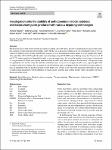Item Infomation
Full metadata record
| DC Field | Value | Language |
|---|---|---|
| dc.contributor.author | Annette, Wagner | - |
| dc.contributor.author | Stefan, Dussling | - |
| dc.contributor.author | Alexander, Nowak | - |
| dc.date.accessioned | 2023-04-21T09:31:38Z | - |
| dc.date.available | 2023-04-21T09:31:38Z | - |
| dc.date.issued | 2023 | - |
| dc.identifier.uri | https://link.springer.com/article/10.1007/s00217-023-04252-7 | - |
| dc.identifier.uri | https://dlib.phenikaa-uni.edu.vn/handle/PNK/8228 | - |
| dc.description | CC BY | vi |
| dc.description.abstract | Blackcurrant juices were produced with an oxygen-excluding spiral filter press and two conventional pressing systems exerting common oxygen exposure at pilot plant scale (200 kg) in technological duplicate in two subsequent years (n = 4). In contrast to findings on previously studied fruits, contents of total and individual anthocyanins were not significantly higher after spiral filter (1636–1872 mg/L) than after conventional pressing (1529–2083 mg/L). During storage for 52 weeks at 4, 20 and 37 °C, anthocyanin levels depended strongly on storage temperature, but not on the used pressing system (conventional vs. oxygen-reduced). Other juice quality parameters like ascorbic acid behaved likewise. | vi |
| dc.language.iso | en | vi |
| dc.publisher | Springer | vi |
| dc.subject | anthocyanins | vi |
| dc.subject | various dejuicing technologies | vi |
| dc.title | Investigations into the stability of anthocyanins in model solutions and blackcurrant juices produced with various dejuicing technologies | vi |
| dc.type | Book | vi |
| Appears in Collections | ||
| OER - Khoa học Tự nhiên | ||
Files in This Item:

